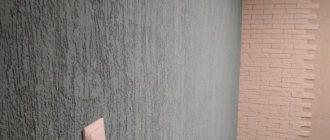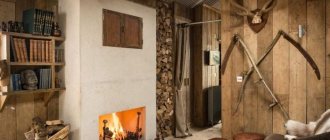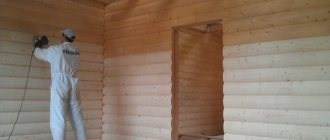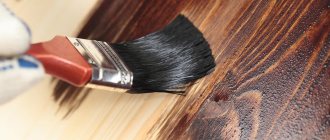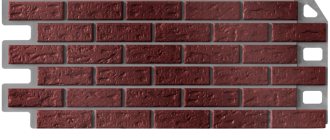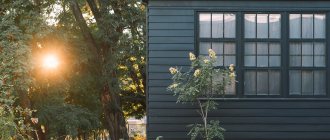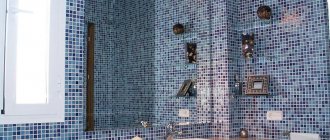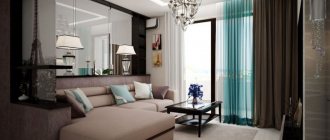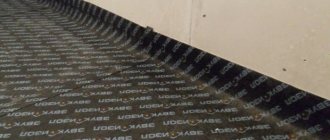Home / Types of ceilings / Wooden / Using a blockhouse to decorate the ceiling
The name “blockhouse”, in fact, means the lining that has long been familiar to everyone. There is, however, a difference - such material will no longer be produced in the form of flat dies, but will have one rounded side, which imitates the rounded surface of a log.
This type of decor is used mainly for finishing external walls or surfaces of houses, but nothing will prevent it from being used equally effectively inside the house. In particular, they cover walls and ceilings. This is done in order to imitate finishing with a solid beam or log.
This type of decoration is becoming more and more fashionable, but not many people can afford a house or other building made of solid and real wood, therefore, it can be replaced with an imitation.
The walls and ceiling in the photo are made using blockhouse decor. The imitation is so accurate that not everyone will be able to discern the substitution.
Peculiarities
- Sanding is carried out along the wood fibers, so there will be no transverse marks (like after an angle grinder).
- The duration of processing one square meter of surface is only 2-5 minutes.
- The attachment is suitable for use with polishers or brush sanders for sanding wood.
- The job does not require any special skills or professional training.
- If the brushes become clogged with tree resin, cleaning with a cleaning pencil is allowed.
- Can be used for removing old finishes from walls and for sanding blockhouses.
The speed and quality of the result are influenced by the properties of the material being processed: wood type, type of pre-treatment, age, log diameter, presence of defects. For example, rounded timber, popular in the construction of private houses, cottages, and dachas, is processed easily, quickly, with minimal wear of the brushes. A log affected by mold, with traces of scraping, transverse nicks or risks will require more physical and time expenditure. The processing of inter-crown joints depends on the diameter of the log - the smaller, the better the result. In particular, on diameters of 20-25 cm, the crown joints can be processed completely, but on 50-60 cm, difficulties may arise.
Subtleties of choice
The fundamental criterion for choosing a block house is its grade. To make the block house ceiling decoration look attractive, you should pay attention to grade A and extra-class products, since their surface is predominantly smooth, without unfused knots, foreign inclusions and mechanical damage.
To make the ceiling structure more expressive, it is advisable to give preference to narrower and thinner examples of a block house, that is, specialized for interior decoration. This move will help to obtain a fairly relief, multifaceted surface and visually “raise” the ceiling.
It is worth paying attention to coniferous species, since it is they who, as it was in the internal microclimate of the room, fill it with the pleasant smell of a coniferous forest.
However, hardwoods produce the most durable, stable and hard products. In addition, larch is naturally endowed with protection from possible processes of rotting and mold growth, which is certainly important for residential premises.
In the store, you should check the integrity of the packaging - it is a guarantee not only of the safety of the panels, but also of maintaining the humidity level set at the production site.
You also need to make sure that the block house is stored correctly - this eliminates the possibility of bending the planks or deformation, which subsequently leads to poor joining of the panels and imperfect surface integrity.
It is necessary to buy material only from one batch, since different batches may differ slightly in color characteristics.
Differences between DE-TERO® KELO and nylon brushes
Wood sanding machines, which come with nylon brushes, are designed for brushing - “artificial aging” of wood.
Thin nylon threads impregnated with abrasive material provide a point load on the wood, polishing soft wood fibers, while they wear out quite quickly due to friction against each other. DE-TERO® KELO brushes are made from natural cactus fibers called sisal or tampico, made from the leaves of the agave plant (Agava sisolana). The brushes are equipped with abrasive petals 2 cm wide, which do not abrade themselves during operation, but work purely for their intended purpose. This ensures high performance and longevity of the system.
Characteristics and properties of a block house for the ceiling
The ancestor of the block house is considered to be lining, from which it inherited the longitudinal grooves on the reverse side, necessary to ensure ventilation between the ceiling and the panels themselves. As well as tongue-and-groove locking elements designed to connect the planks into a single web.
Production includes several stages:
- Selection of high-quality material, mainly coniferous, as well as oak or maple.
- Cutting sorted logs using the “square in a circle” technology. The resulting inner part serves as blanks for ordinary boards, and the outer side goes directly to the manufacture of a block house.
- Drying.
- Cutting connecting grooves and ridges, hollows on the back side.
- Treatment.
- Checking for compliance with regulatory documentation.
- Packaging of finished products.
Types of ceiling block house
Block house material can be used for ceiling decoration:
- Designed directly for interior work. Its thickness is 2.2 cm, width is 9.9 cm, and the length is not standardized and can reach 3 m.
- Universal, its installation is possible both for interior decoration and for cladding facades. The thickness of such products is 3.6 cm, width - 14.2 cm, and length 3 and 6 m.
- Wide, optimized for both internal and external work. The thickness of the wide panels is 2.8 cm, width - 14.2 cm, length 3 and 6 m.
In addition to the traditional block house with rounded cylindrical smooth curves, another variety is produced, the front side of which is cut out in the form of a rectangle.
With this cutting technology, a small chamfer is removed, resulting in a subtype of block house called imitation timber. Most often it is made of pine, but ultra-thin larch panels are also available. The main area of their use is just interior work, in particular, finishing the ceiling.
Classification by variety
Like all profile wood products, the block house for interior ceiling decoration is divided into grades:
- Extra-class - panels of the highest quality, eliminating the presence of knots and other wood defects and mechanical damage. This board is characterized by a perfectly planed surface.
- A – well-planed products, with the possible presence of fused knots of various shades;
- B – normally polished block house. Fused knots with a maximum diameter of 3 cm, micro-scratches and areas of different shades are allowed.
- C - acceptable processed planks with a sufficient number of small damages, defects in the form of unfused knots and many areas of different color.
What you need to know about safety precautions
- Use special glasses and a respirator to protect your eyes and respiratory organs.
- Use clothes without hanging elements.
- The bushing must be securely fastened to the tool - no play, no runout.
- While working, check the reliability of the bushing and the condition of the rubber bands.
- Watch your hands and keep them out of the work area.
IT IS STRICTLY PROHIBITED:
- Operate the equipment if any defects or breakdowns are detected.
- With the system running, take measurements, check the smoothness of the surface with your palm, and perform additional grinding with other abrasives.
- Release the handle before the grinder motor has completely stopped.
Unfortunately, we do not have the opportunity to test all existing brands and models of tools, but based on feedback from our customers, we recommend the following list: , , , , , , DeWALT DWP849X, , .
Are you planning to buy a tool for sanding logs? Call us - we will provide detailed advice and help you make a decision.
Other grinding systems
Advantages and disadvantages of a ceiling block house
As such, the internal ceiling block house has phenomenal strength, wear resistance and dimensional stability as it undergoes a lengthy drying process.
It attracts with its lightness, which is especially important when it comes to finishing the ceiling. This property of the block house allows you to install it even independently, and convenient locking elements further simplify the task. If an individual strip is damaged, it can be easily replaced with a new one or sanded.
Elements dried to a moisture level not exceeding 12% are under reliable protection from the proliferation of fungal growths and rotting.
Another undeniable advantage that the block house has for interior ceiling decoration is environmental friendliness, complemented by hypoallergenicity.
These properties are the result of the constant release of resin and phytoncides from coniferous wood, which suppress the growth of harmful microorganisms and the proliferation of bacteria. In addition, the resin improves the waterproofing characteristics of the panels.
The sufficient thickness of the panels with grooves on the reverse side contributes to excellent thermal and sound insulation of the room in combination with good moisture and vapor permeability. In addition, block house material withstands constant exposure to UV rays and does not change its original color.
It is impossible not to note the low cost associated with the possibility of waste-free production, which makes the price of block house slats quite attractive.
The aesthetic and presentable appearance of the finish, recreating the log vaults of a log house, immerses you in the atmosphere of ancient wooden mansions, striking in their massiveness and nobility.
The block house is not without its drawbacks, including flammability and poor water resistance, which requires periodic treatment of the coating with special compounds.
Ceiling ideas
Such a diverse natural material gives rise to many ideas for beautiful and unusual uses. The following options for installing lining on the ceiling are often found:
- Minimalistic approach. Suitable for lovers of modern styles: the ceiling (often together with the walls) is covered with clapboard in natural, preferably light, shades. This solution creates a feeling of spaciousness; You can diversify the palette using furniture, textiles, and decor.
White painted lining makes the bedroom visually wider Source saucyintruder.org
- Zoning of space. To do this, use lining of two colors or build two levels. Both techniques help to zone the space easily, naturally and without excessive expenses.
- Figured display. Instead of boring sequential installation, the lining is laid out in a herringbone, diamond, diagonal, square pattern with alternating directions. Even a single-color design will make the interior more dynamic and original.
The ceiling as the main design element Source paint-work.ru
- Combination of materials. It is rarely used, although the result is harmonious and effective. As a complement to the cladding board, choose a suspended ceiling or plasterboard; the design can be contrasting.
- Beams and false blocks. A proven way to emphasize certain style trends is to use false beams. Their role will be successfully played by large format boards laid across the main ceiling cladding.
Ceilings with false blocks in modern interiors Source dekorator-s.ru
- Covering a gable ceiling. Sheathing the ceiling of an attic or A-frame house is a classic and almost irreplaceable way to finish a complex surface.
An additional effect can be achieved not only by painting the lining on the ceiling, but also by additional processing. For example, a brushed surface looks interesting when the wood is tinted in two colors, emphasizing the texture. The finish can also be given an aged look using stain and other compounds. To consolidate the result, the ceiling is coated with varnish, wax or oil.
Interiors with an emphasis on the ceiling Source dekorator-s.ru
Finishing with imitation timber
Almost any imitation can be used for ceilings: pine, spruce, larch and thermowood. Another thing is that, unlike the facade, to decorate the ceiling with imitation timber, the narrowest board is taken - 140 cm. Anything wider is best used in very spacious and high rooms - a wide beam visually slightly conceals the space, but adds good quality and respectability to the interior.
The boards are mounted on the sheathing, and “Volna”, DUET 90, self-tapping screws for interior decoration, clamps and spacers are used for fastening. They are invisible once installed, provide proper clearances for ventilation and can withstand the load of a solid heavy board.
For finishing imitation timber, a lot of paints and varnishes are produced, from classic oil to bright azures. What and how to cover the ceiling is a matter of taste.
Ceiling finishing with 3D wall panels
Do not look at the word “wall” in the name of the material. Look at the result: a voluminous, three-dimensional ceiling with a stereoscopic effect. The 3D panels that we make from thermo-ash and larch can be mounted on both walls and ceilings. Enough sheathing and the correct screws for installation.
The length of the panels is 630 and 990 mm, which allows you to arrange them on the ceiling of both large and modest rooms. Finishing options - for every taste: one- and two-color oil tinting, brushing, varnishing or glazing, manual milling, waxing, etc. When decorating the ceiling with wood, we do not recommend narrowing the scope too much: there are always alternatives in price, practicality and methods sales materials.
If you need help choosing, including from two or three ceiling lining options, call us at tel. 8 800 301-31-84, write by e-mail or leave a question in the feedback form. We will calculate the costs, compare the budget, and advise on the specifics of fasteners and installation.
How to install such a covering
The installation process itself will not be much more complicated than installing the most common plastic panels. Essentially, everything is exactly the same - lathing, clamps, nails or screws, and decorative coating.
First, the sheathing is constructed. In the best way, for the construction of a frame base, invented metal profiles are suitable, but you can also take wooden bars.
If wood is used, then you need to take parts at least 30 millimeters thick to ensure the necessary ventilation gap and the overall strength of the structure.
The outer covering is mounted on the sheathing, using self-tapping screws or special mounting plates, plank by plank.
Everything happens exactly the same as when installing conventional MDF panels or plastic trim. One part is inserted into another using the tongue-and-groove method, ensuring sufficient strength of the resulting coating.
A little trick: when installing, position the boards so that the tenon is located towards the light source. This slightly masks the junction of the two planks.
The planks can be fixed either simply with self-tapping screws or with the help of clamps. The method of fixation does not matter much here. Whichever one is more convenient is worth using. Craftsmen usually prefer to use clamps, but you can get by with self-tapping screws.
It is not recommended to use nails when installing such structures, since they do not ensure reliable fixation of the planks.
What can a blockhouse be used for?
Most often, as already mentioned, a blockhouse can be seen in the design of the external walls of a house. Indoors, blockhouses are also often used to decorate walls. But there is also an unexpected application - making a ceiling covering from a blockhouse, as in the previous photo.
This design is appropriate if, in general, the decorating style is consistent with a “wooden” theme. A very typical example would be country style.
It is in the village style that you can most often see decor made from natural wood and the use of materials found in nature. You can also build a house from natural or laminated timber.
The first option will cost a lot, since the cost of anything made from real wood is very high, and the second option will not have the most beautiful appearance.
By using materials that imitate solid timber or logs, you can save significantly. And a blockhouse is one of the best ways to imitate wood.
